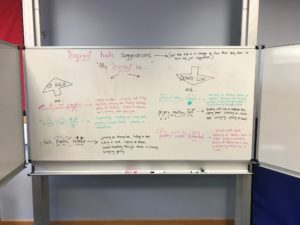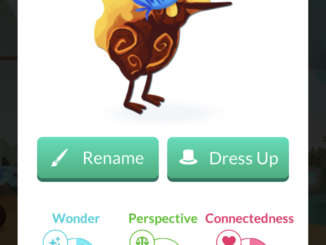It can be really tricky to teach children how to understand the emotions inside of their bodies. It feels obvious after you already know all the emotion words — maybe, depending on how in tune you actually feel with your ability to interpret your own emotions! — but it’s much harder to do from the ground up. Take that and add in layers of complication from diagnoses or other educational challenges, and the difficulty level can really skyrocket.

The transcription of this entire board is available at the introductory post to this series: What the Therapy Gym Is.
That’s why when I was drawing this reminder on the whiteboard in my therapy gym, for the adults who take kids there to self-regulate throughout the day, I didn’t just want to talk about what might for what emotion word (mad, silly, scared, sleepy, sad, distracted) — I wanted to also give descriptor, physical feeling, “interoception” words. Like burning, buzzing, wiggly, floppy, fast, frantic, slow, drippy, melty, dreamy, zoney.
I don’t know about you, but I actually use goofy and nonconventional words like these all. the. time in my day to day life. I find them so much more fun and also so much more descriptive and relatable than simple emotion words are sometimes.
Talking to a friend about why I was feeling extra-emotional and crying easily over things, I referred to myself as feeling “squishy”.
When I was very tired recently and my brain seemed to be taking forever to process things, I referred to myself as feeling “slowed down”.
Excited and enthusiastic to participate in my favorite hobby, I referred to myself as feeling “flappy” and “bouncy”.
Could I say “excited and enthusiastic”? I sure could, and I would easily be able to access that language to explain myself. Why say flappy and bouncy instead? Well, it’s one less step of “translation” I have to do from my body and behavior into language. If I’m flappy and bouncy, it’s because, if I look down at my body, I notice my hands are flappy, my feet are bouncing. Or even if I’m sitting, I’m rocking back and forth a little bit and I’m bouncing up and down a little bit.
It also bypasses some of the positive/negative stigma that gets attached to emotion words. I want children to learn that no emotions are good or bad, they just are — but they still do pick up messages about emotions that are comfortable, uncomfortable, bad, good, positive, negative. And they don’t all always align! Most of us would probably, gut feeling, call the emotion “excitement” “good” — but excitement might also be uncomfortable. (My son gets so anxious with his excitement that it’s hard for him and he starts doing things that he only does when his body is uncomfortable.)
Describing the body behavior/action instead of trying to pin it to an emotion bypasses a lot of that. I might be flappy and bouncy when I’m enthusiastic and excited, someone else might be when they’re anxious and nervous, someone else might be when they’re feeling silly and playful. We can do the work of untangling all of that for our own knowledge and benefit. We can also pretty easily derive the fact that if someone is feeling bouncy and needs to move their energy level to a calmer state, jumping on the trampoline might work well for them. We can derive that much easier from the word “bouncy” than from the emotion-word interpretation (which may or may not even be correct).



